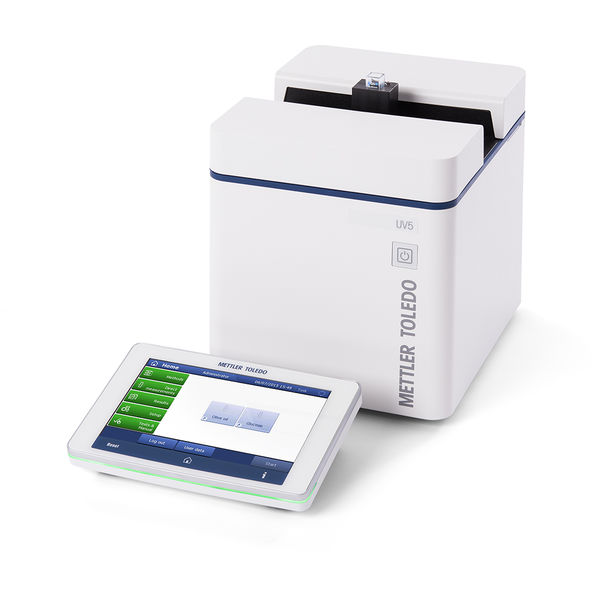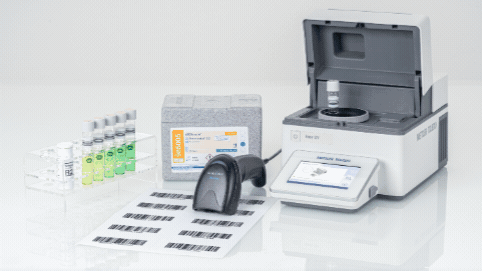Anorganische Verbindungen spielen eine wichtige Rolle für die Wasserqualität. Ihr Vorhandensein oder Fehlen kann sich erheblich auf das Leben im Wasser, die menschliche Gesundheit und industrielle Prozesse auswirken. Mit der UV/Vis-Spektrophotometrie kann die Konzentration verschiedener anorganischer Substanzen zuverlässig bestimmt werden.
Nitrat
Nitrat ist eine Verbindung auf Stickstoffbasis, die häufig in Gewässern vorkommt. Obwohl ein zu hoher Nitratgehalt für das Pflanzenwachstum in kleinen Mengen unerlässlich ist, birgt er erhebliche Risiken für Umwelt und Gesundheit. Nitratverunreinigungen stammen häufig aus landwirtschaftlichen Abwässern, Auswaschungen aus Düngemitteln und Abwassereinleitungen. Hohe Nitratkonzentrationen im Trinkwasser können zu ernsthaften gesundheitlichen Problemen führen. Darüber hinaus trägt Nitrat zur Eutrophierung bei, was zu schädlichen Algenblüten und Sauerstoffmangel in den Gewässern führt. Die UV/Vis-Spektrophotometrie ist eine weit verbreitete Methode zur Bestimmung der Nitratkonzentration, die eine effektive Überwachung und Bewirtschaftung der Wasserqualität ermöglicht.
Ammoniak
Ammoniak ist ein farbloses Gas mit einem stechenden Geruch, das aufgrund der Zersetzung organischer Stoffe häufig in Abwässern und landwirtschaftlichen Abwässern vorkommt. Hohe Ammoniakwerte sind giftig für Wasserlebewesen und stören deren Atmungsorgane. Darüber hinaus kann Ammoniak auch zur Eutrophierung beitragen, was wiederum zu Sauerstoffmangel in den Gewässern führt. Die UV/Vis-Spektrophotometrie kann in Verbindung mit geeigneten Reagenzien die Ammoniakkonzentrationen genau bestimmen und ermöglicht so ein effektives Wasserqualitätsmanagement.
Fluorid
Fluorid ist ein Mineral, das für die Zahngesundheit unerlässlich ist und Karies vorbeugt. Ein übermäßiger Fluoridkonsum kann jedoch zu Zahnfluorose und schwererer Skelettfluorose führen. Eine genaue Fluoridmessung ist entscheidend für die Aufrechterhaltung einer optimalen Wasserqualität und der öffentlichen Gesundheit, nicht nur im Trinkwasser, sondern auch in Dentalprodukten. Die UV/Vis-Spektrophotometrie ermöglicht durch Methoden wie die Alizarin-Zirkonyl-Komplex-Analyse eine präzise Fluoridbestimmung sowohl in Wasser als auch in Dentalprodukten und gewährleistet so die Einhaltung von Sicherheitsstandards.
Phosphat
Phosphate sind essentielle Nährstoffe für das Pflanzenwachstum, einschließlich der Wasservegetation. Überschüssige Phosphate können jedoch ein übermäßiges Pflanzenwachstum stimulieren, was zu einem Ungleichgewicht im Ökosystem führt. Die UV/Vis-Spektrophotometrie wird häufig zur Überwachung der Phosphatkonzentrationen in Gewässern eingesetzt.
Chlorid
Chlorid ist ein natürlich vorkommendes Anion, das in Wasser vorkommt. Obwohl hohe Chloridwerte in moderaten Mengen für die menschliche Gesundheit unerlässlich sind, können sie dem Wasser einen salzigen Geschmack verleihen und zur Korrosion der Wasserinfrastruktur beitragen. Chloridverunreinigungen stammen häufig aus industriellen Abwässern, dem Eindringen von Salzwasser oder Auftausalzen. Die UV/Vis-Spektrophotometrie kann eingesetzt werden, um den Chloridgehalt effektiv zu überwachen.
Arsen
Arsen ist ein giftiges Metalloid, das natürlicherweise in einigen Grundwasserquellen vorkommt. Es kann auch Wasser durch industrielle Aktivitäten und landwirtschaftliche Praktiken verunreinigen. Eine chronische Exposition gegenüber Arsen kann zu verschiedenen Gesundheitsproblemen führen, darunter Hautläsionen, Atemwegsprobleme und ein erhöhtes Krebsrisiko. Die UV/Vis-Spektrophotometrie kann in Kombination mit geeigneten Probenvorbereitungstechniken zum Nachweis und zur Quantifizierung von Arsen in Wasser eingesetzt werden.
Bor
Bor ist ein essentieller Mikronährstoff für Pflanzen, kann aber in erhöhten Konzentrationen für den Menschen giftig sein. Bor kommt natürlich in der Umwelt vor und kann durch verschiedene Aktivitäten in Wasserquellen gelangen, darunter industrielle Prozesse, Landwirtschaft und Auswaschung aus Gesteinen und Böden. Ein übermäßiger Borkonsum kann die reproduktive Gesundheit und Entwicklung beeinträchtigen, insbesondere bei Kindern. Daher ist die Überwachung des Borgehalts im Wasser von entscheidender Bedeutung. Die UV/Vis-Spektrophotometrie in Kombination mit geeigneten Analysemethoden kann die Borkonzentration genau bestimmen und so die Wasserqualität und die öffentliche Gesundheit gewährleisten.
Eisen
Eisen ist ein essentielles Element für lebende Organismen, aber ein zu hoher Eisengehalt kann ästhetische Probleme wie Verfärbungen und Flecken verursachen. Eisen kann auch zum Wachstum von Eisenbakterien beitragen, die Rohre verstopfen und den Wasserfluss verringern können. Die UV/Vis-Spektrophotometrie ist eine gängige Methode zur Bestimmung der Eisenkonzentration in Wasser, die eine wirksame Behandlung und Vorbeugung von eisenbedingten Problemen ermöglicht.
Kupfer
Kupfer ist ein essentielles Spurenelement für die menschliche Gesundheit, aber eine übermäßige Exposition kann zu einer Kupfervergiftung führen, die durch Magen-Darm-Symptome, Leberschäden und Nierenprobleme gekennzeichnet ist. Kupfer kann durch industrielle Abwässer, Korrosion von Kupferrohren und landwirtschaftliche Abwässer in Gewässer gelangen. Die UV/Vis-Spektrophotometrie kann zur Überwachung des Kupfergehalts im Wasser eingesetzt werden.
Magnesium
Magnesium ist ein lebenswichtiger Mineralstoff, der wesentlich zur Wasserhärte beiträgt. Obwohl es für die menschliche Gesundheit unerlässlich ist, kann überschüssiges Magnesium die Wasserqualität und die täglichen Aktivitäten beeinträchtigen. Die Magnesiumkonzentrationen variieren stark, wobei Meerwasser im Vergleich zu Süßwasserquellen deutlich höhere Werte enthält. Die Aufrechterhaltung eines optimalen Magnesiumgehalts ist entscheidend, um die Bildung von Kalkablagerungen zu verhindern, eine effiziente Waschmittelleistung zu gewährleisten und die Langlebigkeit wasserbasierter Systeme zu sichern. Die UV/Vis-Spektrophotometrie in Kombination mit geeigneten Reagenzien kann die Magnesiumkonzentrationen genau bestimmen und so die Wasseraufbereitung und -bewirtschaftung unterstützen.
Blei
Blei ist ein hochgiftiges Metall, von dem keine sichere Exposition bekannt ist. Es kann sich im Körper anreichern und schwere gesundheitliche Probleme verursachen, insbesondere bei Kindern. Bleiverunreinigungen im Wasser stammen oft von alten Bleirohren, industriellen Abwässern und bleihaltigem Benzin. Die UV/Vis-Spektrophotometrie kann als Teil eines umfassenden Bleitestprogramms zum Schutz der öffentlichen Gesundheit eingesetzt werden.
































